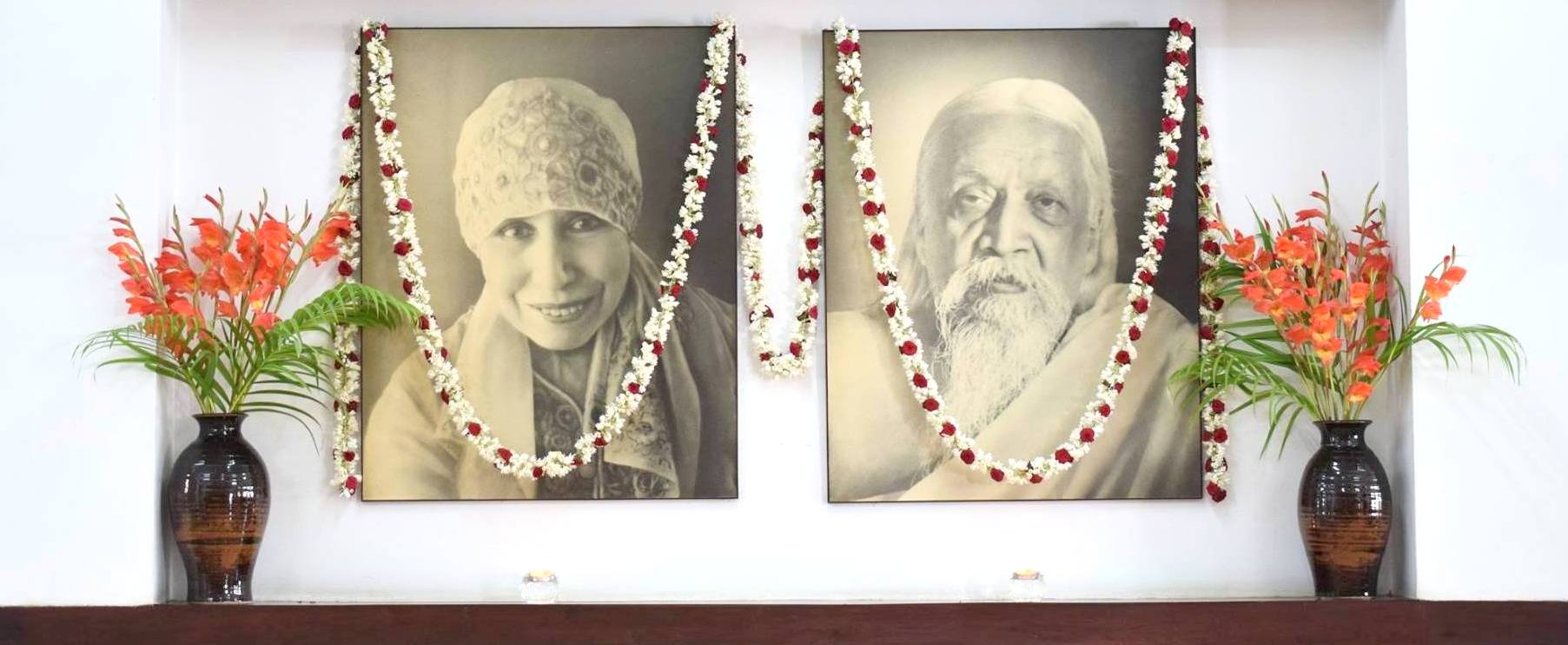While Sri Aurobindo didn’t ask disciples to regard themselves as his equals or anything of the sort, at the same time he did not specifically instruct them in a set of dos and don’ts with regard to their relation with him. Consistent with the spirit of the Time he respected the law of freedom given to each individual to use or misuse it at his own peril and risk. Even the surrender which he regarded as the core principle of yoga had to be a state of a glad and free self-giving of oneself to the Divine. It is the Mother in fact who taught the disciples what it means to relate to the Master so that they could evolve in a much faster and safer way by their contact with Him. For Herself however again out of a divine humility She reserved the role of a worker and the Mother. It is through Her own divine example that the disciples learnt what it means to relate to the Master.
Herself an adept in various forms of yoga, a master of occult forces and powers, yet she would take upon Herself the role of a devoted worker who is ever in the service of Her Lord. If Sri Aurobindo had not revealed Her inner Truth to his disciples many would have wondered about who or what She is. Her prayers are again a wonderful document of how we should relate with the Divine. And in that the one word that repeats itself as a most common refrain almost musical to the ears is the word Lord. After all She is the Shakti of the Iswara, literally the Lord. When She came here She would refer to the him either as Sri Aurobindo or simply the Lord, even as He would call Her the Mother. Hence quite naturally these words have gathered a special power and become mantric in nature. Some like Dilip Kumar Roy referred to him as the Guru whereas many older days disciples quite naturally referred to Sri Aurobindo as the Lord and to the Mother as very simply Mother. This much for the historical and spiritual context of this word.
More impersonally, it is true he did not believe in the conventional approach to the Master often laden with outer reverence but missing on the inner essential. Also Sri Aurobindo is an example par excellence in humility and compassion. So when he says what he says it is his supreme humility. But when we quote what he says and apply it to our relation with him then it is not humility but arrogance. This is how many shastras are misunderstood and misapplied. Let me give it as an example of letters written by Sri Aurobindo for the Teachers of Integral Yoga. He knew that teachers are prone to vanity and suffer a fall due to the spiritual ego. Hence the need for humility can never be over emphasized.
Let us see for ourselves both of these.
“The Teacher of the integral Yoga will follow as far as he may the method of the Teacher within us. He will lead the disciple through the nature of the disciple. Teaching, example, influence, —these are the three instruments of the Guru. But the wise Teacher will not seek to impose himself or his opinions on the passive acceptance of the receptive mind; he will throw in only what is productive and sure as a seed which will grow under the divine fostering within. He will seek to awaken much more than to instruct; he will aim at the growth of the faculties and the experiences by a natural process and free expansion. He will give a method as an aid, as a utilisable device, not as an imperative formula or a fixed routine. And he will be on his guard against any turning of the means into a limitation, against the mechanising of process. His whole business is to awaken the divine light and set working the divine force of which he himself is only a means and an aid, a body or a channel. It has always been held in Indian yoga that the relation between Guru and disciple must be one of full confidence and full acceptance of the Guru by the Shishya. The latter was supposed to accept unquestioningly the guidance and to follow the instructions of the Guru without criticism or questioning; he was not supposed to criticise, to blame or to refuse adhesion or to follow in a questioning or grudging spirit: for that would stand in the way of his advance. The Indian disciple of those days would not have expected the Guru to suit his directions or instructions or ways of leading to the mental demands or vital ideas of the [incomplete]
The example is more powerful than the instruction; but it is not the example of the outward acts nor that of the personal character which is of most importance. These have their place and their utility; but what will most stimulate aspiration in others is the central fact of the divine realisation within him governing his whole life and inner state and all his activities. This is the universal and essential element; the rest belongs to individual person and circumstance. It is this dynamic realisation that the sadhaka must feel and reproduce in himself according to his own nature; he need not strive after an imitation from outside which may well be sterilising rather than productive of right and natural fruits.
Influence is more important than example. Influence is not the outward authority of the Teacher over his disciple, but the power of his contact, of his presence, of the nearness of his soul to the soul of another, infusing into it, even though in silence, that which he himself is and possesses. This is the supreme sign of the Master. For the greatest Master is much less a Teacher than a Presence pouring the divine consciousness and its constituting light and power and purity and bliss into all who are receptive around him.
And it shall also be a sign of the teacher of the integral Yoga that he does not arrogate to himself Guruhood in a humanly vain and self-exalting spirit. His work, if he has one, is a trust from above, he himself a channel, a vessel or a representative. He is a man helping his brothers, a child leading children, a Light kindling other lights, an awakened Soul awakening souls, at highest a Power or Presence of the Divine calling to him other powers of the Divine.
***
However to use this as to what a disciple’s relation should be with the Master is to reverse the whole truth and by doing so falsify it completely. It is to take a statement completely out of context and giving it a slight twist and sleight of logic use it to satisfy the need of preserving the ego individuality. So here is something that relates to what should be the disciple’s attitude towards the Guru.
There are three conditions for a disciple for profiting fully from his relation to a spiritual guide.
1st: He must accept him entirely and him alone without submitting himself to any contrary or second influence.
2nd: He must accept the indications given by the Guru and follow them firmly and with full faith and perseverance to the best of his own spiritual capacity.
3rd: He must make himself open and receptive to the Guru for even more than what the Guru teaches to the mind of the disciple, it is what he spiritually is, the spiritual consciousness, the knowledge, the light, the power, the Divinity in him that helps the disciple to grow by his receiving that into himself and its being used within himself for the growth of his consciousness and nature into its own divine possibility.
***
What the Guru can do for the sadhak depends upon the latter’s receptivity—not upon any method or rule of sadhana. Certain psychological conditions or attitudes of the consciousness tend to increase the receptivity—e.g., humility towards the Guru, devotion, obedience, trust, a certain receptive passivity to his influence. The opposite things—independence, a critical attitude, questionings—go the other way and make it necessary for the Guru to help only indirectly or behind the veil. But the main thing is a kind of psychological openness in the consciousness which comes or increases of itself with the help of the will to receive and the right attitude. If there is that then it is not necessary to pull anything from the Guru, only to receive quietly. Pulling from him often draws untruly or things for which the consciousness is not ready to assimilate.
***
It is a deficiency of psychic perception and spiritual discrimination that makes people speak like that [in a depreciatory way] and ignore the importance of obedience. It is the mind wanting to follow its own way of thinking and the vital seeking freedom for its desires which argue in this manner. If you do not follow the rules laid down by the spiritual guide or obey one who is leading you to the Divine, then what or whom are you to follow? Only the ideas of the individual mind and the desires of the vital: but these things never lead to siddhi in Yoga. The rules are laid down in order to guard against certain influences and their dangers and to keep a right atmosphere in the Asram favourable to spiritual development; the obedience is necessary so as to get away from one’s own mind and vital and learn to follow the Truth.
***
Up to now no liberated man has objected to the Guruvada; it is usually only people who live in the mind or vital and have the pride of the mind or the arrogance of the vital that find it below their dignity to recognise a Guru.
***
One has to learn from the master and act according to his instructions because the master knows the subject and how it is to be learnt—just as in spiritual things one has to follow the Guru who has the knowledge and knows the way. If one learns all by oneself, the chances are that one will learn all wrong. What is the use of a freedom to learn wrongly? Of course if the pupil is more intelligent than the master, he will learn more than the master, just as a great spiritual capacity may arrive at realisations which the Guru has not—but even so, the control and discipline in the early stages is indispensable.
***
Because through it [surrender to the Guru] you surrender not only to the impersonal but to the personal, not only to the Divine in yourself but to the Divine outside you; you get a chance for the surpassing of ego not only by retreat into the Self where ego does not exist, but in the personal nature where it is the ruler. It is the sign of the will to complete surrender to the total Divine, samagram mam manusım tanum as ritam. Of course it must be a genuine spiritual surrender for all this to be true.
***
No [surrender to the Divine and surrender to the Guru are not two different things]. In surrendering to the Guru, it is to the Divine in him that one surrenders—if it were only to a human entity it would be ineffective. But it is the consciousness of the Divine Presence that makes the Guru a real Guru, so that even if the disciple surrenders to him thinking of the human being to whom he surrenders, that Presence would still make it effective.”
In other words to get a drift of Sri Aurobindo’s writings it is best to read everything that he has written on a subject. Its practical applications are found in the Mother’s writings. Together they give us the complete truth in its theoretical as well as the completest possible practical framework.
Having said that it is also true that in the Integral Yoga the relation of the disciple to the Master or Guru is only one such relation that may develop between the soul struggling with the ignorance of earth-nature and the Divine. But there are many other forms of relation that may develop between the soul and the Supreme.
“The relation of Guru and disciple is only one of many relations which one can have with the Divine, and in this Yoga which aims at a supramental realisation, it is not usual to give it this name; rather, the Divine is regarded as the Source, the living Sun of Light and Knowledge and Consciousness and spiritual realisation and all that one receives is felt as coming from there and the whole being remoulded by the Divine Hand. This is a greater and more intimate relation than that of the human Guru and disciple, which is more of a limited mental ideal. Nevertheless, if the mind still needs the more familiar mental conception, it can be kept so long as it is needed; only do not let the soul be bound by it and do not let it limit the inflow of other relations with the Divine and larger forms of experience. “
It depends upon the number of contact points between our being and the Divine, our past evolution and future curve of destiny. Even it may be from the very beginning many-hued and many-sided as indicated in this aphorism:
“Discipleship to God the Teacher, sonship to God the Father, tenderness of God the Mother, clasp of the hand of the divine Friend, laughter and sport with our Comrade and boy Playfellow, blissful servitude to God the Master, rapturous love of our divine Paramour, these are the seven beatitudes of life in the human body. Canst thou unite all these in a single supreme and rainbowhued relation? Then hast thou no need of any heaven and thou exceedest the emancipation of the Adwaitin.”
As is our faith and as we approach Him so does the Divine respond. So while referring to Sri Aurobindo as The Lord may sound a certain kind of religious formulation to some in a certain context it is very much a valid form of relation to someone else who does feel the Master as the Lord, The Ishwara, who governs his own and the world destiny. The discipline of Indian yoga, does ask or advice the disciple to see all the gods and the trinity in the Guru, at least as a representative of the Supreme if not the Supreme Himself. Of course there should be nothing dogmatic about it. There is even another extreme that says one can even approach the Divine as an enemy and He then comes in the mask of an enemy since that is what is required for our growth. As is our faith and as men approach Him so does the Divine take joy in them – ये यथा मां प्रपद्यन्ते तांस्तथैव भजाम्यहं [Bhagavad Gita 4:11].




